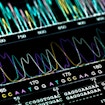
Autism spectrum disorders (ASDs) are genetically heterogeneous, but whether they share a common neural-circuit-processing defect is unclear. One hypothesis is that the ratio of excitation to inhibition (the E/I ratio) in the brain's cerebral cortex is elevated in ASDs. Elevations in this ratio could cause hyperexcitability of neural circuits, leading to impaired information processing and hypersensitivity to sensory stimuli, features commonly seen in individuals with ASD.


